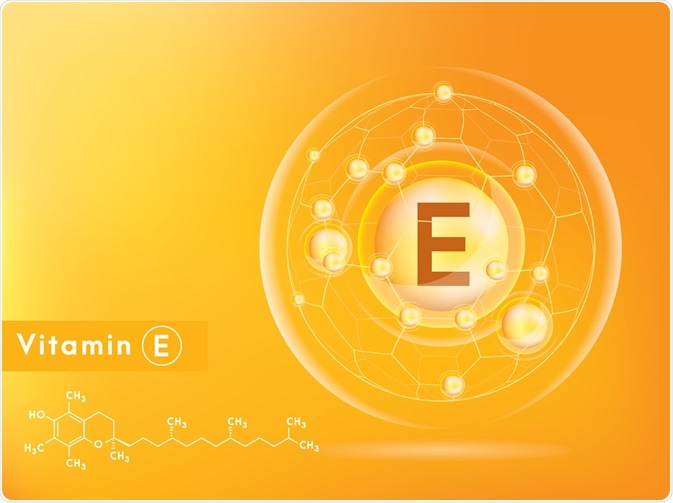Natural vitamin E contains 8 isoforms, of which four are alpha, beta, gamma and delta-tocotrienols. They differ because of the presence or absence of a methyl (-CH3) group at the 2, 4’ and 8’ positions on the chromanol ring. Natural tocotrienols have this group in the R configuration at the 2 position, which is responsible for its biological activity.
 Image Credit: Adisak Riwkratok/Shutterstock.com
Image Credit: Adisak Riwkratok/Shutterstock.com
Sources of tocotrienols
Tocotrienols are far less common in plants than tocopherols. However, vitamin E in monocot seeds and a few dicot seeds are mostly in the form of tocotrienols. The richest source of alpha-tocotrienol is the oil of the oil palm tree Elaeis guineensis, containing up to 800 mg/kg of this vitamin in the alpha and gamma isoforms. 70% of vitamin E in palm oil is in the form of tocotrienols, quite unlike other plant oils which contain exclusively tocopherols.
Functions of tocotrienols
Tocotrienols are powerful antioxidants, and neutralize peroxyl radicals better than alpha-tocopherol. In cell research, these molecules, especially the delta isoform, show the ability to promote apoptosis and prevent cell proliferation of malignant cell lines.
The importance of alpha-tocotrienol is being reassessed today because it has biological activity that is not accounted for by its antioxidant properties.
- It is able to prevent the oxidative metabolism of arachidonic acid (AA), which is among the most plentiful polyunsaturated fatty acids (PUFA) in the brain. Unfortunately, AA is also vulnerable to destruction by oxidation when the brain is injured in any way. It is part of the bilayered neuronal membrane, from which it is cleaved by cytosolic phospholipase A2, and further metabolized via several pathways. This disruption of normal PUFA pathways is found to occur in several neurodegenerative conditions, the best-known being acute ischemic stroke. The products of arachidonic acid peroxidation accumulate, acting as modulators of neuronal action and triggering the cascade of events that culminates in neuronal death. By preventing this sequence of neuronal events, tocotrienols act as potent neuroprotective agents.
Tocotrienol derived from palm oil appears to be capable of preventing the metabolic breakdown of arachidonic acid by inhibiting all the pathways. In addition, it has a separate inhibitory effect on the degeneration of the brain cells. This is achieved at concentrations of a few nanomoles, making it the most powerful biological function to be associated with natural vitamin E in any form.
- Micromolar concentrations of tocotrienols also inhibit the activity of HMG-CoA, the enzyme which catalyzes the synthesis of cholesterol in the liver, and the target of statins. Murine research suggests strongly that dietary alpha-tocotrienol supplementation restores fertility in rats that are deficient in alpha-tocopherol transporter protein (alpha-TTP), proving that this compound is capable of reaching tissues in the body in sufficient quantities for bioavailability.
- In addition, tocotrienols have shown promising anti-cancer properties in a number of cancer cell lines. This may be due to several mechanisms such as its inhibition of proliferation, promotion of apoptosis, antioxidant activity, inhibition of angiogenesis and of HMGCoA reductase. They reduce oxidative damage to proteins. In rats, gamma-tocotrienol maintained normal vitamin D and calcium metabolism when they were fed on a diet deficient in vitamin E.
Chemistry of tocotrienol
Tocotrienol has a chromanol head just like alpha-tocopherol, but its hydrocarbon tail consists of an unsaturated isoprenoid chain, unlike the saturated isoprenoid structure of the tocopherol. It has three unsaturated bonds at the 3’, 7’ and 11’ positions. It manifests only less than a third of the biological activity of alpha-tocopherol.
However, its antioxidant potency is 40-60 times as high as that of alpha-tocopherol when its inhibitory effect on lipid peroxidation was studied. It was shown to protect essential liver cytochromes 6.5 times better.
This increased efficiency was thought to be due to a more uniform distribution through the bilayer because of its increased penetration into bilayers which have saturated fat, a greater capacity to recycle after being oxidized to its chromanoxyl form, and its ability to get closer to more free radicals because of its disordering of membrane lipid molecules.
References
Further Reading
Last Updated: Dec 19, 2022